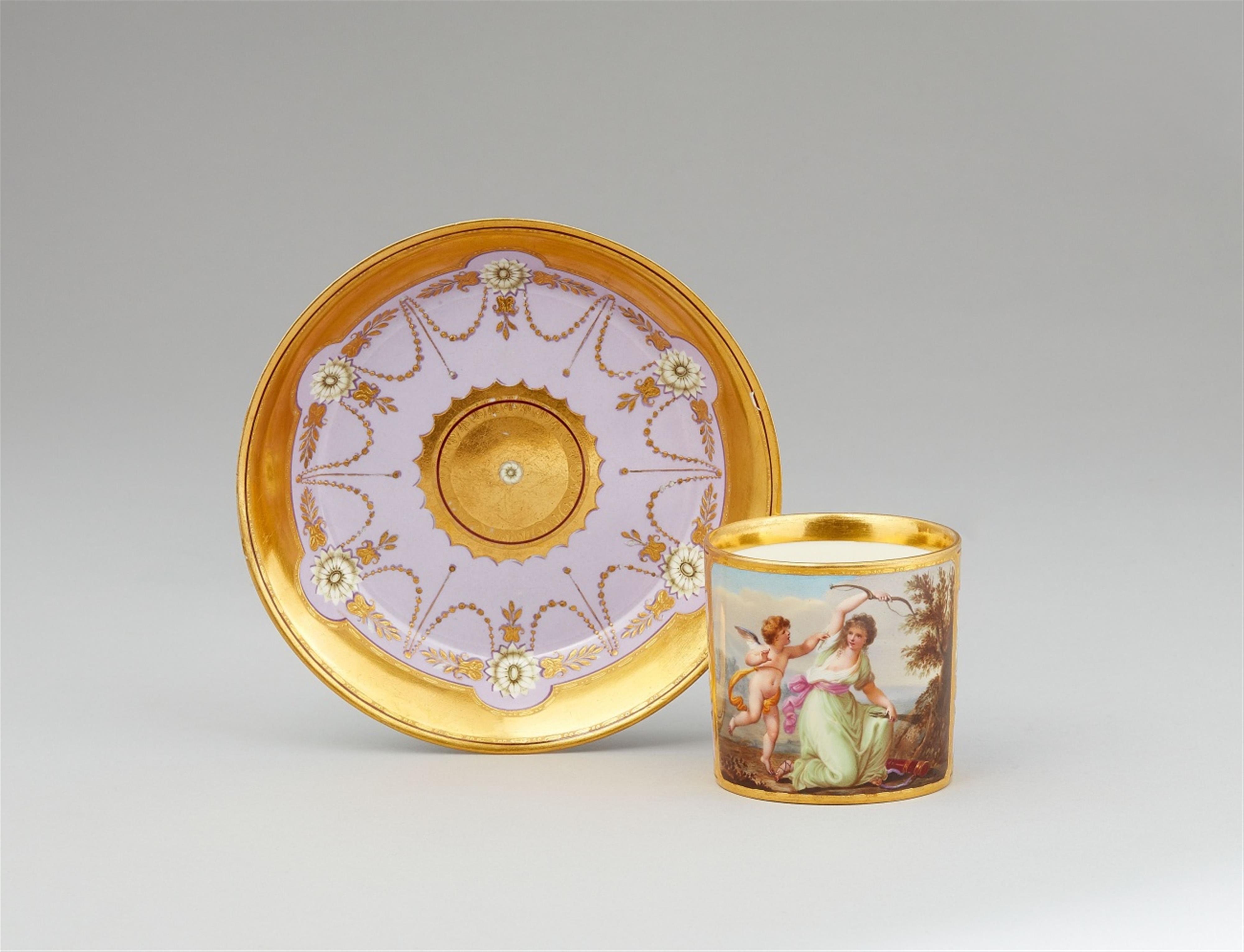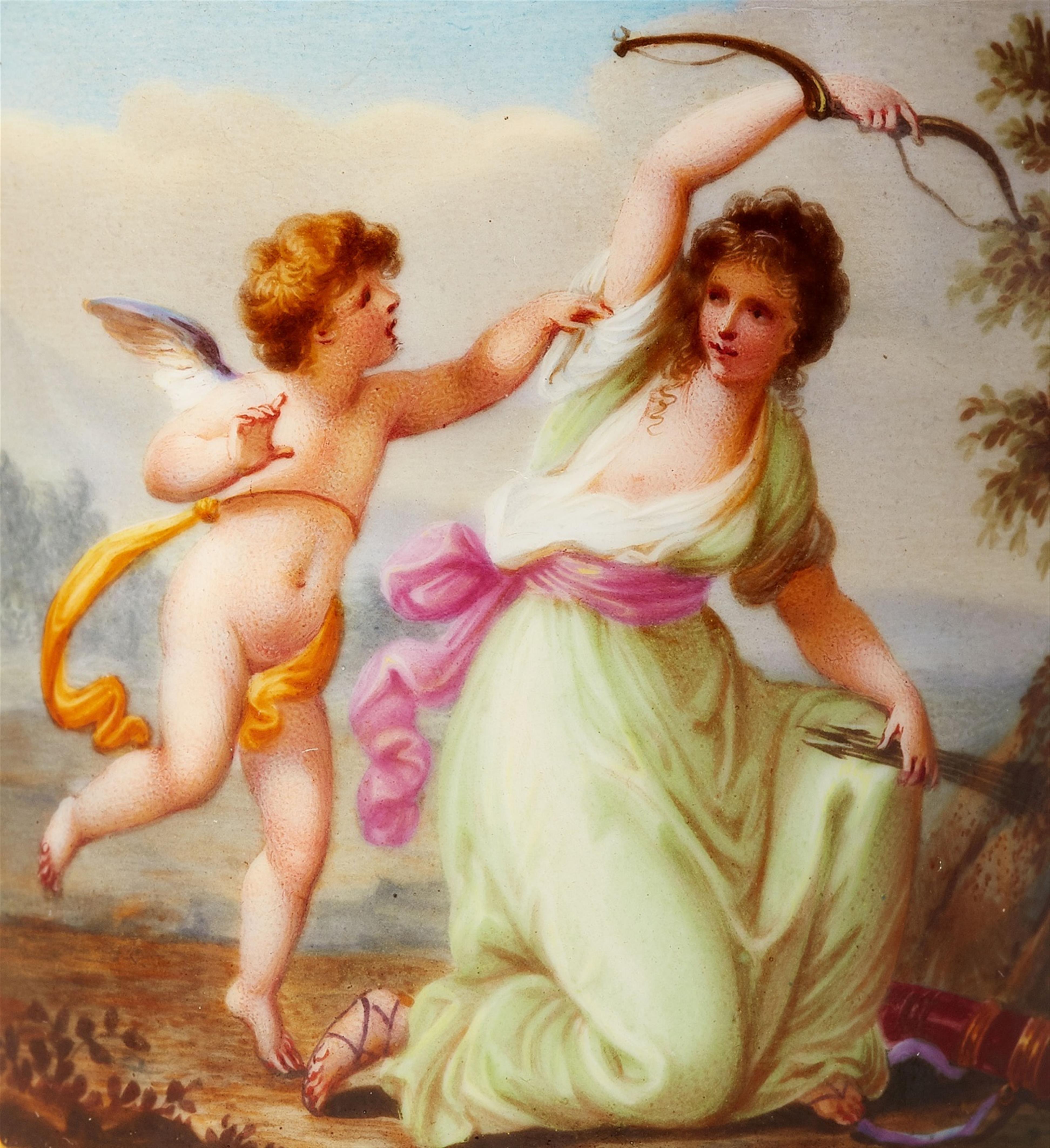Tasse mit Entwaffnung des Amor nach Angelika Kauffmann
Porzellan, farbiger Aufglasurdekor, heller Purpurfond, Goldfond und reliefierte Vergoldung. Zylindrisch, mit zugehöriger UT. Auf der Tasse in einem eckigem Goldrahmen die Darstellung "Amor von Euphrosyne entwaffnet". Auf der hinteren Wandung und im Spiegel der UT Perlenketten zwischen Rosetten en grisaille. Blaumarke Bindenschild, Jahresstempel 804, purpurne 96., Drehernummer 47 (Tasse) für Mathias Schwaiger und 51 (UT).
Wien, Kaiserliche Manufaktur unter Konrad von Sorgenthal, 1804, bemalt von Anton Kothgasser.
A legend in her own right: Angelika Kauffmann (1741-1807)
Melitta Kunze-Köllensperger
Known as La Madonna long before the days of emancipation, gender studies, or pop stars, her profile could have been that of a modern woman: A cosmopolitan polyglot who spoke four languages and was at home on every European stage, Angelika Kauffmann was educated and intellectual whilst still remaining charming and humble despite her glittering career.
People's fascination with this exceptional artist, her success, and her talent, were already the subject of commentary during her lifetime. Goethe, Herder, and Winckelmann were among her many friends in Rome and praised Angelika Kauffmann's intellect and grace: “A woman of enormous talent”, “perhaps the most cultivated woman in Europe”, the “tenth Muse of Rome”. In London she was nominated by Sir Joshua Reynolds to become a founding member of the Royal Academy in 1768.
Copies of her famous paintings were a popular motif on Vienna porcelain of the Sorgenthal period, a time in which the manufactory was more concerned than ever with appealing to the contemporary zeitgeist, creating edifying products, and advancing technologically. It therefore seems only natural that alongside the works of old masters such as Carlo Cignani (1628 - 1719) - as in lot 48, which shows a painting proven to have been housed in the Kunsthistorisches Museum Vienna since 1783 - the cups, plates, and vases of the Vienna manufactory should feature numerous compositions by Angelika Kauffmann (*1741 in Chur + 1807 in Rome). These miniature sized pieces were perfectly suited to decorate the private art collections of the upper middle classes.
In the days before exhibitions and artistic publications, printed reproductions of paintings played an important role in promoting the fame of their artists and elevating the image of their owners. Around 280 engravings of works by Angelika Kauffmann were already available in the year 1810.
Mythological subjects belonged to the genre of history painting, which placed a focus on the study of instructive subjects as an important aspect of an enlightened observation of art. Thus, the moralised and stylised emotions found in Angelika Kauffmann's works reflected the sensitive tastes of her era. The engravings made of these works, many of which were acquired by graphics collection of the Albertina in Vienna, were frequently studied and copied by the artists of the imperial porcelain manufactory. For example, a print in the collection of the Albertina entitled “Fancy's sweetest Child” which was engraved in 1782 by Francesco Bartolozzi and references a verse from Thomas Wharton's poem “The Enthusiast or the Love of Nature”. The verse describes how the personification of fancy discovers Shakespeare as a baby, brings him to a cave and charms his ears with the most beautiful of songs. Angelika Kauffmann depicts the “Birth of Shakespeare” with the curious child sitting in the lap of an allegory of fancy with wings in her hair - a composition which the porcelain painters of Royal Vienna interpreted on a saucer as a mother and child (lot 42).
The world of nymphs, graces, maenads, and Cupid formed an inexhaustible and perennially popular source of inspiration: “Two Nymphs awakening Love”, engraved by William Wynne Ryland in 1776 and painted on a Vienna porcelain cup symbolises the moment in which young girls discover love for the first time (lot 43). The design of a further teacup (lot 44) shows one of the Graces, Euphrosyne, as an allegory of joy confiscating Cupid's bow so that he can no longer create mischief or break any more hearts. Angelika Kauffmann was inspired to this motif by a poem by Pietro Metastasio (known as Pietro Trapassi) entitled “Le Grazie vendicate” (1735). An engraving of this work made by Thomas Burke in 1784 can be found in the Albertina in Vienna under the title “Cupid disarmed by Euphrosyne”.
Provenienz
Wiener Privatsammlung.




